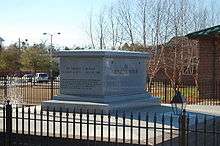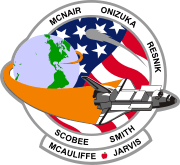Ronald McNair
| Ronald Erwin McNair | |
|---|---|
 | |
| NASA Astronaut | |
| Nationality | American |
| Status | Killed during mission |
| Born |
October 21, 1950 Lake City, South Carolina, U.S. |
| Died |
January 28, 1986 (aged 35) Cape Canaveral, Florida, U.S. |
Other occupation | Physicist |
Time in space | 7d 23h 15m |
| Selection | 1978 NASA Group |
| Missions | STS-41-B, STS-51-L |
Mission insignia |
|
| Awards |
|
Ronald Erwin McNair (October 21, 1950 – January 28, 1986) was a physicist and NASA astronaut. McNair died during the launch of the Space Shuttle Challenger on mission STS-51-L.
Background
Born October 21, 1950, in Lake City, South Carolina, his parents were Pearl M. and Carl C. McNair. He had two brothers, Carl S. and Eric A. McNair.
In the summer of 1959, he refused to leave the segregated Lake City Public Library without being allowed to check out his books. After the police and his mother were called, he was allowed to borrow books from the library, which is now named after him.[1] A children's book, Ron's Big Mission, offers a fictionalized account of this event.
McNair graduated as valedictorian of Carver High School in 1967.[2]
In 1971 he received a Bachelor of Science degree in Engineering Physics, magna cum laude, from North Carolina A&T State University in Greensboro, North Carolina.[3] McNair was a member of Omega Psi Phi Fraternity.[3] In 1976, he received a Ph.D. degree in Physics from the Massachusetts Institute of Technology under the guidance of Prof. Michael Feld, becoming nationally recognized for his work in the field of laser physics.
He received three honorary doctorates, a score of fellowships and commendations and achieved a black belt in karate.
After graduation from MIT, he became a staff physicist at the Hughes Research Lab in Malibu, California. McNair was a member of the Bahá'í Faith.[4]

Astronaut
In 1978, McNair was selected as one of thirty-five applicants from a pool of ten thousand for the NASA astronaut program. He flew on STS-41-B aboard Challenger from 3–11 February 1984, as a mission specialist becoming the second African American and the first Bahá'í to fly in space.
Following this mission, McNair was selected for STS-51-L, which launched on 28 January 1986, and was subsequently killed when Challenger disintegrated nine miles above the Atlantic Ocean just 73 seconds after liftoff.[5]
Music in space
McNair was an accomplished saxophonist.
Before his last fateful space mission he had worked with the composer Jean Michel Jarre on a piece of music for Jarre's then-upcoming album Rendez-Vous. It was intended that he would record his saxophone solo on board the Challenger, which would have made McNair's solo the first original piece of music to have been recorded in space[6] (although the song "Jingle Bells" had been played on a harmonica during an earlier Gemini 6 spaceflight). However, the recording was never made as the flight ended in disaster and the deaths of its entire crew. The last of the Rendez-Vous pieces, (Last Rendez-Vous) had the additional name "Ron's Piece". Ron McNair was supposed to take part in the concert through a live feed.
Public honors


A variety of public places, people and programs have been renamed in honor of McNair.
- The crater McNair on the Moon is named in his honor.
- The McNair Building at MIT, his alma mater, houses the Kavli Institute for Astrophysics and Space Research.
- Watson Chapel Jr. High was renamed the R. McNair Jr. High School in his honor.
- Ronald McNair Boulevard in Lake City, South Carolina, is named in his honor and lies near other streets named for astronauts who perished in the Challenger crash.
- The U.S. Department of Education offers the TRIO Ronald E. McNair Post-Baccalaureate Achievement Program for students with low income, first generation students, and/or underrepresented students in graduate education for doctorate education.
- On January 29, 2011, the Lake City, South Carolina, library was dedicated as the Ronald McNair Life History Center.[2] When Ronald McNair was nine, the police and his mother were called because he wished to check out books from this library, which served only white patrons before he arrived. He said, "I'll wait," to the lady and sat on the counter until the police and his mother arrived, and the officer said, "Why don't you just give him the books?" which the lady behind the counter reluctantly did. He said, "Thank you, Ma'am," as he got the books.[1]
- Several K-12 schools have also been named after McNair.
- McNair Memorial Park in El Lago, Texas is named in his honor.[7]
- Ronald E. McNair Middle School in Lake City, South Carolina, was renamed from Carver High School in his honor (he was a high school graduate of the facility).
- Dr. Ronald E. McNair Academic High School in Jersey City, New Jersey[8]
- Ronald McNair Elementary School currently under construction in Greensboro, North Carolina
- Ronald McNair Elementary School in Germantown, Maryland
- Ronald E. McNair Prince Hall Masonic Lodge No. 146 is named in his honor in Suitland, Maryland [9]
- Dr. Ronald E. McNair High School in Atlanta, Georgia
- Ronald E. McNair Middle School, San Antonio, Texas – Southwest ISD
- Ronald McNair Middle School in Decatur, Georgia
- Ronald McNair Middle School in College Park, Georgia
- Ronald E. McNair Administrative Center in University City, Missouri
- Ronald E. McNair Elementary School in Hazelwood, Missouri [10]
- Ronald Ervin McNair Elementary School in Denton, Texas (Denton ISD)
- Ronald McNair Middle School in Rockledge, Florida
- Ronald E. McNair Elementary School in Dallas, Texas (Dallas ISD)
- Ronald E. McNair Academic Center in Chicago, Illinois
- Ronald E. McNair Junior High School in Huntsville, Alabama[11]
- Ronald McNair Middle School[12] in East Palo Alto, California
- Ronald E. McNair High School in Stockton, California
- PS 5, Dr. Ronald McNair School in Brooklyn, New York
- PS/MS 147 Ronald McNair in Cambria Heights Queens, New York
- McNair Elementary School in Compton, California.
- Ronald E. McNair Building: KIPP Believe College Prep. New Orleans, Louisiana
- A building on the Willowridge High School campus in Houston, Texas, is named in honor of McNair.
- There is a memorial in the Ronald McNair Park in Brooklyn, New York in his honor.[13][14]
- The Dr. Ronald E. McNair Playground in East Harlem, New York, New York, is named after him.[15]
- The Ronald E. McNair Space Theater inside the Davis Planetarium in downtown Jackson, Mississippi, is named in his honor.
- The Naval ROTC building on the campus of Southern University and A&M College in Baton Rouge, Louisiana is named in his honor.
 Ronald E. McNair Hall, On the campus of North Carolina A&T State University in Greensboro, North Carolina
Ronald E. McNair Hall, On the campus of North Carolina A&T State University in Greensboro, North Carolina - The Engineering building at North Carolina A&T State University in Greensboro, NC is named in his honor.
- The McNair Post-baccalaureate Achievement Program, which operates at 179 campuses in the U.S. (April 7), awards research money and internships to first-generation and otherwise underrepresented students in preparation for graduate work.[16]
- McNair was portrayed by Joe Morton in the 1990 TV movie Challenger.
- The song, "A Drop Of Water," recorded by Japanese jazz artist Keiko Matsui, with vocals by the late Carl Anderson, was written in tribute to McNair.
- The Jean Michel Jarre track Last Rendez-Vous was re titled Ron's Piece in his honor. McNair was originally due to record the track in space aboard Challenger, and then perform it via a live link up in Jarre's Rendez-vous Houston concert.
- Michigan State University Ronald E. McNair Post-Baccalaureate Achievement Achievement Program/ Summer Research Opportunity Program is a nationally recognized undergraduate research program designed to encourage first-generation and low-income college juniors and seniors to enter doctoral study.
See also
References
- 1 2 "Astronaut's Brother Recalls A Man Who Dreamed Big". January 28, 2011. Retrieved November 18, 2012.
- 1 2 Smith, Bruce (2011-01-28). "Small SC town pauses to remember astronaut son". TheState.com. Retrieved 2011-01-29.
- 1 2 "Ronald E. McNair Bio". jsc.nasa.gov. NASA. Retrieved 25 March 2014.
- ↑ Venters, Louis E., the III (2010). Most great reconstruction: The Baha'i Faith in Jim Crow South Carolina, 1898–1965 (Thesis). Colleges of Arts and Sciences University of South Carolina. ISBN 978-1-243-74175-2. UMI Number: 3402846.
- ↑ NASA Biography
- ↑ Synth History
- ↑ http://www.ellago-tx.gov/misc/park-pics.html, last accessed September 16, 2013
- ↑ Hague, Jim. "In a Class By Itself". Jersey City Magazine, Spring & Summer 2011. page 55
- ↑ http://www.mwphglmd.org/Fourth-Masonic-District.html
- ↑
- ↑ Bryan, Shevaun (August 5, 2014). "New school, old building: first day of school at McNair Junior High". Huntsville, AL: WHNT-TV. Retrieved September 7, 2014.
- ↑ Ronald McNair Academy, accessed January 28, 2011.
- ↑ Dr. Ronald E. McNair Park, Crown Heights, Brooklyn
- ↑ "Historical Sign Listings : NYC Parks". Nycgovparks.org. Retrieved 2012-05-18.
- ↑ "Dr. Ronald McNair Playground". Retrieved 2012-11-23.
- ↑ "TRIO – Ronald E. McNair Postbaccalaureate Achievement Program – Home Page". Ed.gov. 2012-05-09. Retrieved 2012-05-18.
External links
| Wikimedia Commons has media related to Ronald McNair. |
- McNair Foundation to encourage and mentor science, mathematics and technology students
- Spacefacts biography of Ronald McNair
- Ronald E. McNair Post – Baccalaureate Achievement Program
- Official NASA Bio
- Ronald E. McNair Postbaccalaureate Achievement Program
- StoryCorps: Astronaut's Brother Recalls A Man Who Dreamed Big
- Ron's Big Mission – A story about an event in Ron's childhood
- Ronald McNair at Find a Grave
- Ronald McNair at Find a Grave

